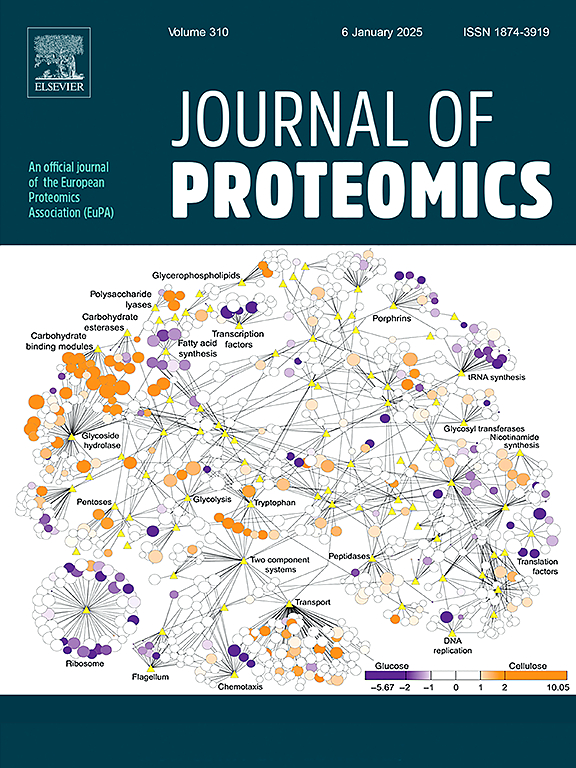Global profiling of protein lysine Malonylation during goat intramuscular Preadipocyte differentiation
IF 2.8
2区 生物学
Q2 BIOCHEMICAL RESEARCH METHODS
引用次数: 0
Abstract
Enhancing intramuscular fat (IMF) to improve the quality of livestock product has long been a goal in animal breeding. Recent studies have revealed a strong connection between malonylation and lipid metabolism, yet the function of malonylated proteins in ruminants largely unclear. In the present study, we identified the third day of goat intramuscular preadipocyte differentiation as a critical time point for lipid accumulation, with no significant alterations in malonylation levels. We identified 212 and 216 malonylated proteins on day 0 (d0) and day 3 (d3) of differentiation, respectively, enrichment in pathways such as glycolysis/gluconeogenesis, tight junctions, and actin cytoskeleton regulation. Our findings demonstrate the consistent presence of malonylation during preadipocyte differentiation, with minor quantitative variations, and highlight key malonylated proteins closely associated with lipid metabolism, including acetyl-CoA carboxylase (ACACA), translation control tumor protein 1 (TPT1), phosphoglycerate kinase 1 (PGK1), annexin A6 (ANXA6), and annexin A2 (ANXA2). Collectively, our study uncovers critical malonylated proteins during preadipocyte differentiation, establishing a foundation for exploring their roles in intramuscular fat deposition.
Significance
Currently, efforts are being made to improve meat quality by enhancing intramuscular fat (IMF) deposition, thereby promoting the development of the livestock industry. This study addresses a critical gap in our understanding of malonylation, a key post-translational modification, in livestock. By constructing the first malonylation protein modification map in goats and revealing dynamic changes during intramuscular preadipocyte differentiation, this research offers novel insights into the regulatory roles of malonylation in fat deposition. The findings not only advance the field of livestock proteomics but also provide a theoretical foundation for improving meat quality and exploring metabolic regulation in animals.

山羊肌内前脂肪细胞分化过程中蛋白质赖氨酸丙二酸酰化的全局分析。
提高肌内脂肪含量以提高畜产品质量一直是畜禽育种的目标。最近的研究揭示了丙二酰化与脂质代谢之间的密切联系,但丙二酰化蛋白在反刍动物中的功能尚不清楚。在本研究中,我们确定山羊肌内前脂肪细胞分化的第三天是脂质积累的关键时间点,丙二酰化水平没有显著改变。我们分别在分化的第0天(d0)和第3天(d3)鉴定了212和216个丙二酰化蛋白,这些蛋白在糖酵解/糖异生、紧密连接和肌动蛋白细胞骨架调节等途径中富集。我们的研究结果表明,在前脂肪细胞分化过程中,丙二醛化的存在是一致的,只是数量上有轻微的变化,并强调了与脂质代谢密切相关的关键丙二醛化蛋白,包括乙酰辅酶a羧化酶(ACACA)、翻译控制肿瘤蛋白1 (TPT1)、磷酸甘油激酶1 (PGK1)、膜联蛋白A6 (ANXA6)和膜联蛋白A2 (ANXA2)。总的来说,我们的研究揭示了前脂肪细胞分化过程中关键的丙二酰化蛋白,为探索它们在肌内脂肪沉积中的作用奠定了基础。意义:目前,人们正在努力通过增加肌内脂肪(IMF)沉积来改善肉质,从而促进畜牧业的发展。这项研究解决了一个关键的差距,在我们的理解丙二醛化,一个关键的翻译后修饰,在牲畜。通过构建山羊丙二酰化蛋白修饰图谱,揭示肌内前脂肪细胞分化过程中的动态变化,本研究为丙二酰化在脂肪沉积中的调节作用提供了新的见解。这一发现不仅推动了畜禽蛋白质组学研究的发展,也为提高畜禽肉质和探索动物代谢调控提供了理论基础。
本文章由计算机程序翻译,如有差异,请以英文原文为准。
求助全文
约1分钟内获得全文
求助全文
来源期刊

Journal of proteomics
生物-生化研究方法
CiteScore
7.10
自引率
3.00%
发文量
227
审稿时长
73 days
期刊介绍:
Journal of Proteomics is aimed at protein scientists and analytical chemists in the field of proteomics, biomarker discovery, protein analytics, plant proteomics, microbial and animal proteomics, human studies, tissue imaging by mass spectrometry, non-conventional and non-model organism proteomics, and protein bioinformatics. The journal welcomes papers in new and upcoming areas such as metabolomics, genomics, systems biology, toxicogenomics, pharmacoproteomics.
Journal of Proteomics unifies both fundamental scientists and clinicians, and includes translational research. Suggestions for reviews, webinars and thematic issues are welcome.
 求助内容:
求助内容: 应助结果提醒方式:
应助结果提醒方式:


